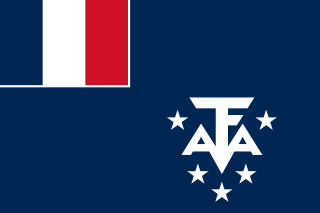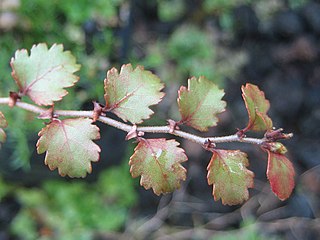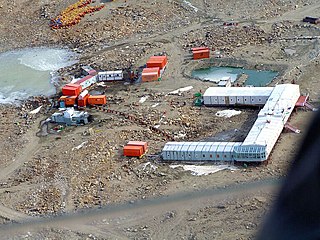
The French Southern and Antarctic Lands is an overseas territory of France. It consists of:

Dakshin Gangotri was the first scientific base station of India situated in Antarctica, part of the Indian Antarctic Programme. It is located at a distance of 2,500 kilometres (1,600 mi) from the South Pole. It is currently being used as a supply base and transit camp. The base is named after Dakshin Gangotri Glacier.

Antarctic flora are a distinct community of vascular plants which evolved millions of years ago on the supercontinent of Gondwana. Presently, species of Antarctica flora reside on several now separated areas of the Southern Hemisphere, including southern South America, southernmost Africa, New Zealand, Australia, and New Caledonia. Joseph Dalton Hooker was the first to notice similarities in the flora and speculated that Antarctica had served as either a source or a transitional point, and that land masses now separated might formerly have been adjacent.

The Antarctic Peninsula, known as O'Higgins Land in Chile and Tierra de San Martín in Argentina, and originally as Graham Land in the United Kingdom and the Palmer Peninsula in the United States, is the northernmost part of mainland Antarctica.

All India Radio (AIR), also known as Akashvani, is India's state-owned public radio broadcaster. Founded in 1936, it operates under the Ministry of Information and Broadcasting and is one of the two divisions of Prasar Bharati. Headquartered at the Akashvani Bhavan in New Delhi, it houses the Drama Section, FM Section, and National Service. It also serves as the home of the Indian television station Doordarshan Kendra.

King George Island is the largest of the South Shetland Islands, lying 120 km off the coast of Antarctica in the Southern Ocean. The island was named after King George III.

Maitri also known as Friendship Research Centre, is India's second permanent research station in Antarctica as part of the Indian Antarctic Programme. The name was suggested by then-Prime Minister Indira Gandhi. Work on the station was first started by the Indian Antarctic expedition which arrived the end of December 1984, with a team led by Dr. B. B. Bhattacharya. Squadron Leader D. P. Joshi, the surgeon of the team, was the first camp commander of the tentage at camp Maitri. The first huts were started by the IV Antarctica Expedition and completed in 1989, shortly before the first station, Dakshin Gangotri, was buried in ice and abandoned in 1990–91. Maitri is situated in the rocky mountainous region called Schirmacher Oasis. It is only 5 kilometres (3.1 mi) away from the Russian Novolazarevskaya Station.

Hinduism has been present in the form of ancient Hinduism or Vedic religion in other parts of the Middle East and influenced the Zoroastrianism and Manichaeism in ancient Persia. Krishna, one of the avatars of Vishnu and prominent Hindu deity, figures prominently in some of religions in the region.

The Indian Antarctic Programme is a multi-disciplinary, multi-institutional programme under the control of the National Centre for Polar and Ocean Research, Ministry of Earth Sciences, Government of India. It was initiated in 1981 with the first Indian expedition to Antarctica. The programme gained global acceptance with India's signing of the Antarctic Treaty and subsequent construction of the Dakshin Gangotri Antarctic research base in 1983, superseded by the Maitri base from 1989. The newest base commissioned in 2012 is Bharati, constructed out of 134 shipping containers. Under the programme, atmospheric, biological, earth, chemical, and medical sciences are studied by India, which has carried out 40 scientific expeditions to the Antarctic.

The National Centre for Polar and Ocean Research (NCPOR) is an Indian research and development institution, situated in Vasco da Gama, Goa. It is an autonomous institution of the Department of the Ministry of Earth Sciences, Government of India which is responsible for administering the Indian Antarctic Programme and maintains the Indian government's Antarctic research stations, Bharati and Maitri. NCPOR was established originally as NCAOR on 25 May 1998, with Dr. Prem Chand Pandey as the founding director.

Visva-Bharati, is a public central university and an Institute of National Importance located in Shantiniketan, West Bengal, India. It was founded by Rabindranath Tagore who called it Visva-Bharati, which means the communion of the world with India. Until independence it was a college. Soon after independence, the institution was given the status of a central university in 1951 by an act of the Parliament.

Multiple governments have set up permanent research stations in Antarctica and these bases are widely distributed. Unlike the drifting ice stations set up in the Arctic, the current research stations of the Antarctic are constructed either on rocks or on ice that are fixed in place.

The Schirmacher Oasis is a 25 km (16 mi) long and up to 3 km (1.9 mi) wide ice-free plateau with more than 100 freshwater lakes. It is situated in the Schirmacher Hills on the Princess Astrid Coast in Queen Maud Land in East Antarctica and is, on average, 100 m (330 ft) above sea level. With an area of 34 km2 (13 sq mi), the Schirmacher Oasis ranks among the smallest Antarctic oases and is a typical polar desert.

Antarctica is Earth's southernmost and least-populated continent. Situated almost entirely south of the Antarctic Circle and surrounded by the Southern Ocean, it contains the geographic South Pole. Antarctica is the fifth-largest continent, being about 40% larger than Europe, and has an area of 14,200,000 km2 (5,500,000 sq mi). Most of Antarctica is covered by the Antarctic ice sheet, with an average thickness of 1.9 km (1.2 mi).

The Larsemann Hills are a series of low rounded coastal hills along the southeastern shore of Prydz Bay, Antarctica extending for 9 nautical miles (17 km) from Dålk Glacier. They were discovered in February 1935 by Captain Klarius Mikkelsen from the whaling ship Thorshavn, sent out by Norwegian whaling magnate Lars Christensen, and given this name.

Chrispus Livingstone, often referred as Livi, is an Indian research scientist, botanist, educator and multifaceted person. He was instrumental in upgrading the department of Botany to one of the top three in India. During his stint the department witnessed significant innovative changes in the curriculum with the introduction of new papers and special projects (optionals) at various levels besides high quality research projects carried out by the senior professors and their research scholars leading to several accomplishments. He was also instrumental in setting up India's first artificial horticulture farm. Among his varied interests is the taxonomy of tropical plants, especially flora of Chennai, then Madras. He is perhaps best known for his book The flowering plants of Madras City and its immediate neighbourhood.

Bharati is a permanent Antarctic research station commissioned by India. It is India's third Antarctic research facility and one of two active Indian research stations, alongside Maitri. India's first committed research facility, Dakshin Gangotri, is being used as a supply base. India has demarcated an area beside Larsemann Hills at 69°S, 76°E for construction. The research station has been operational since 18 March 2012. Since its completion, India has become one of nine nations to have multiple stations within the Antarctic Circle. Bharati's research mandate focuses on oceanographic studies and the phenomenon of continental breakup. It also facilitates research to refine the current understanding of the Indian subcontinent's geological history. News sources have referred to the station as "Bharathi", "Bharti" and "Bharati".

International competition extended to the continent of Antarctica during the World War II era, though the region saw no combat. During the prelude to war, Nazi Germany organised the 1938 Third German Antarctic Expedition to preempt Norway's claim to Queen Maud Land. The expedition served as the basis for a new German claim, called New Swabia. A year later, the United States Antarctic Service Expedition established two bases, which operated for two years before being abandoned. Responding to these encroachments, and taking advantage of Europe's wartime turmoil, the nearby nations of Chile and Argentina made their own claims. In 1940 Chile proclaimed the Chilean Antarctic Territory in areas already claimed by Britain, while Argentina proclaimed Argentine Antarctica in 1943 in an overlapping area.

Felix Bast, born as V. M. Sreejith Nambissan, is an Indian phycologist, author, and public educator based at the Central University of Punjab. He is the member of the high-profile advisory council of International Science Council, Paris, and has discovered seven new species of plants from India and Antarctica.

Dipankar Borah is an Indian field botanist from Assam.


















